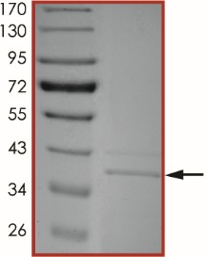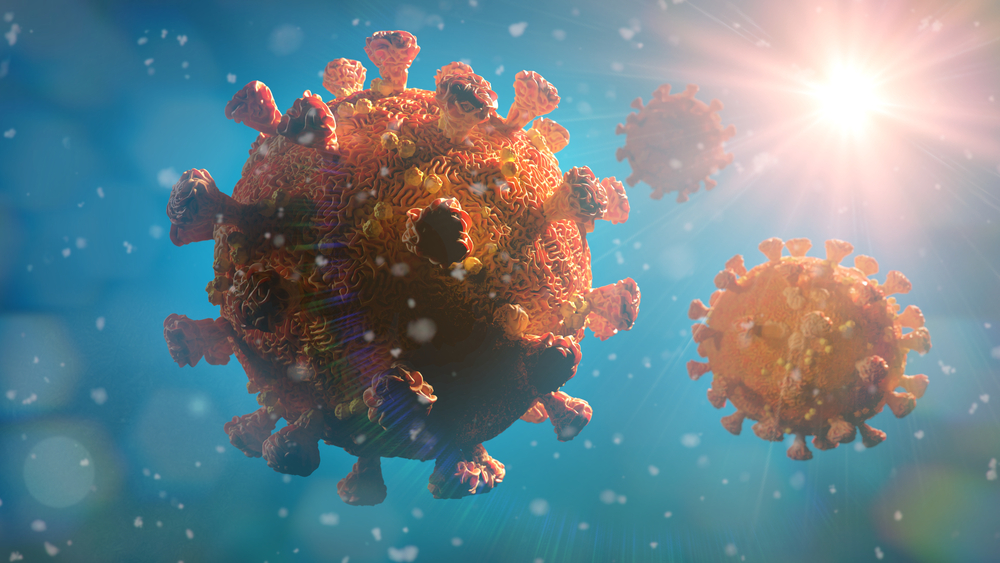
SDS-PAGE: The purity of SARS-CoV-2 PLpro was determined to be ~90% by densitometry, MW ~38 kDa.

Activity & Inhibition Assays: (A) The DUB specific activity of SARS-CoV-2 PLpro was determined to be 7.2 nmol/min/mg as per the DUB activity assay protocol. (B) The protease specific activity of SARS-CoV-2 PLpro was determined to be ≥450 pmol/min/mg at an enzyme concentration of 4µg as per the proteolytic activity assay protocol. (C) PLpro inhibition profile in the presence of various concentrations of PR-619, a broad spectrum and reversible DUB inhibitor.
SARS-COV-2 PAPAIN-LIKE PROTEASE (PLPRO), ACTIVE
Recombinant SARS-CoV-2 papain-like protease (PLpro), part of the large replicase polyprotein 1ab (E1564-Y1882), expressed in E. coli cells with an N-terminal His-tag. SARS-CoV-2, previously known as the 2019 Novel Coronavirus (2019-nCoV), causes the pandemic COVID-19 disease.
PRODUCT DETAILS – SARS-COV-2 PAPAIN-LIKE PROTEASE (PLPRO), ACTIVE
- Recombinant SARS-CoV-2 papain-like protease (PLpro).
- Expressed in E. coli cells with an N-terminal His-tag and ~90% purity.
- Presented as liquid in 50mM sodium phosphate, pH7.5, 300mM NaCl, 150mM imidazole, 1mM DTT, 10% glycerol.
- Activity confirmed by DUB assay.
BACKGROUND
In December 2019 a novel coronavirus, severe acute respiratory syndrome coronavirus 2 (SARS-CoV-2), formerly known as the 2019 novel coronavirus (2019-nCoV) was identified in Wuhan, China, causing a world-wide pandemic. Three coronaviruses, SARS-CoV, MERS-CoV, and SARS-CoV-2 have been identified as being a highly pathogenic for humans, and there is currently no effective antiviral treatment. Therefore, studies are focused on rapid development of vaccines and antiviral drugs to prevent and treat coronavirus infection. There are several potential strategies to pharmacologically fight against the disease (COVID-19), including vaccines, monoclonal antibodies, oligonucleotide-based therapies, peptides, interferon therapies, and small-molecule drugs (Dömling & Gao, 2020). The coronaviral PLpro is an attractive antiviral drug target because it is essential for CoV replication. SARS-CoV-2 papain-like protease (PLpro), also known as SARS- CoV-2 PLpro, is a virally encoded cysteine protease that acts on three cleavage sites of the viral polyprotein to release mature non-structural proteins (nsp) 1, 2 and 3, a process that is essential for viral replication. Although the primary function of PLpro and 3CLpro is to process the viral polyprotein in a coordinated manner, PLpro has the additional function of stripping ubiquitin and ISG15 from host-cell proteins to help CoV to evade the host innate immune responses. PLpro possesses deubiquitinating and deISGylating activities, thus negatively regulating the ubiquitin and ISG15-dependent host immune response during viral infection. PLpro also participates together with nsp4 in the assembly of virally-induced cytoplasmic double-membrane vesicles necessary for viral replication. PLpro is involved in inhibiting the production of cytokines and chemokines, that are responsible for the activation of the host innate immune response against viral infection. Consequently, this enzyme is an important molecular target in the design of SARS-CoV-2 antiviral drugs.
REFERENCES
- Báez-Santos Y. M. et al: The SARS-coronavirus papain-like protease: structure, function and inhibition by designed antiviral compounds. Antiviral Res. 115: 21-38, 2015.
- Dömling A, Gao L. Chemistry and Biology of SARS-CoV-2. Chem. 2020;6(6):1283-1295.
- Lindner H. A. et al: The papain-like protease from the severe acute respiratory syndrome coronavirus is a deubiquitinating enzyme. J Virol. 79:15199-15208, 2005.
- Wu F. et al: A new coronavirus associated with human respiratory disease in China. Nature 579: 265-269, 2020.



